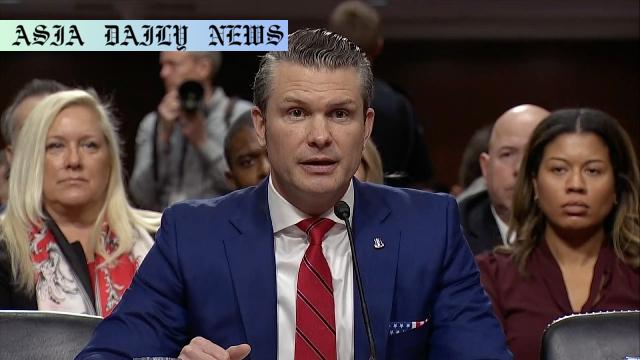Hegseth faces narrow confirmation as US Defense Secretary amidst controversy, with Vice President JD Vance casting tie-breaking vote.
- Hegseth confirmed as US defense secretary in a contentious Senate vote.
- Vice President JD Vance’s tie-breaking vote solidified the confirmation.
- Concerns over Hegseth’s qualifications and controversial remarks linger.
- Hegseth emphasized addressing the growing threat of China.

Narrow Confirmation for Defense Secretary
The U.S. Senate narrowly confirmed Pete Hegseth as the nation’s defense secretary in a historic and contentious vote. The confirmation came after a rare 50-50 split among senators. Vice President JD Vance stepped in to break the tie, making this the second time in U.S. history that a vice president participated in a Cabinet nomination vote. The first such instance also occurred during a Donald Trump administration in 2017. Hegseth’s nomination was fraught with controversy, raising significant concerns about his qualifications and past conduct.
Contentious Background and Controversy
Hegseth’s confirmation has not been met without scrutiny. Allegations of sexual misconduct surfaced during the deliberation process, casting a shadow over the nomination. Moreover, his controversial stance on gender roles in the military has garnered criticism. Hegseth previously stated that women should not serve on battlefields, a viewpoint that has alienated certain members of both the Democratic Party and his Republican colleagues. Despite these concerns, his nomination was pushed forward by President Donald Trump, solidifying Hegseth’s alignment with the administration’s broader political goals.
A Focus on Military Policy
In his testimony before the Senate Armed Services Committee, Hegseth articulated his vision for the U.S. military, largely emphasizing the growing threat posed by China. He remarked, “We will work with our partners and allies to deter aggression in the Indo-Pacific from the communist Chinese.” This rhetoric aligns with the broader U.S. foreign policy focus on countering China’s expansion in the region. While some lawmakers praised his sharp focus on international rivals, others remained skeptical of his leadership amid domestic controversies.
Political Ramifications and Culture Wars
Hegseth’s confirmation is seen as part of a growing trend of politicization within the military. A recent event underscoring this dynamic was the removal of a portrait at the Pentagon. The painting depicted a former chairman of the Joint Chiefs of Staff who had publicly criticized President Trump. The removal has been interpreted by many as an effort to align military messaging with the administration’s political ideology. The New York Times highlighted this instance in its reporting, stating, “Trump Pulls the Military Back Into the Political and Culture Wars.” Such events have raised questions about the impartiality of the armed forces during these politically charged times.
Historic Implications
The confirmation has broader implications for the role of vice presidents and the contentious nature of nominations under divided governance. JD Vance’s tie-breaking vote underscored the delicate balance of power in a polarized Senate and the increasing frequency of closely divided decisions. With this confirmation behind him, Hegseth will now face the challenge of unifying a military potentially divided over political leanings, while also addressing significant strategic concerns abroad, such as China’s rising influence.
Moving Forward
The coming weeks and months will provide a clearer picture of how Hegseth performs as defense secretary. His leadership will be scrutinized as he navigates both international tensions and calls for reform within the U.S. military. Whether or not he can rise above the controversy surrounding his confirmation remains to be seen, but the stakes for America’s security and global standing are impossibly high.



Commentary
An Unprecedented Moment in Confirmation Politics
The confirmation of Pete Hegseth as defense secretary marks a significant moment in U.S. politics. For only the second time in history, a vice president was required to cast a tie-breaking vote on a Cabinet nominee, signaling the deeply divided nature of the Senate. Vice President JD Vance’s decisive vote underscores the razor-thin margins of bipartisan collaboration in today’s political climate.
The Cost of Partisan Politics
Hegseth’s contentious nomination underscores how Cabinet appointments are increasingly shaped by ideological loyalty rather than bipartisan consensus. The scrutiny over his qualifications and personal controversies should serve as a sober reminder of the high stakes associated with leadership roles in national security. Many Americans are left wondering whether partisanship now eclipses merit in determining who will helm critical institutions like the Department of Defense.
What Is at Stake?
The focus on China is undoubtedly a critical component of U.S. foreign policy, and this issue remains a unifying concern across party lines. However, Hegseth’s divisive rhetoric and alleged past conduct could sow discord within the military at a time when cohesion is paramount. The challenge ahead lies not only in managing external threats but also in bridging rifts within the armed services to ensure readiness and morale remain intact.
A Cautious Road Ahead
While Hegseth’s confirmation is now settled, the debate over his suitability to lead will undoubtedly persist. It will take decisive action and a focus on results to establish his credibility and legitimacy in the eyes of the public and international allies. For the sake of national security, it is essential that he succeeds. Yet, the cost of his nomination in terms of political capital and public trust may cast a long shadow over his tenure.